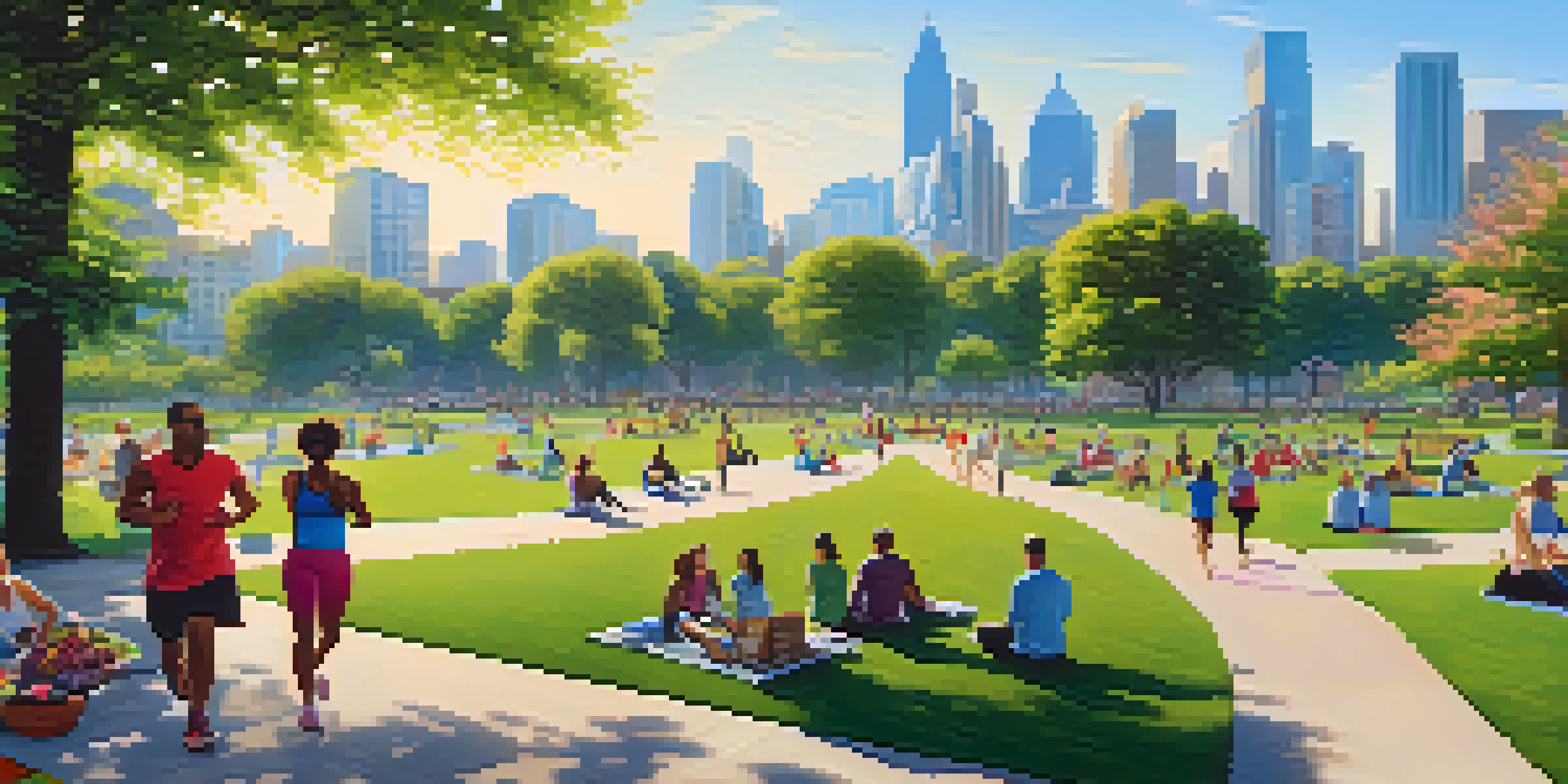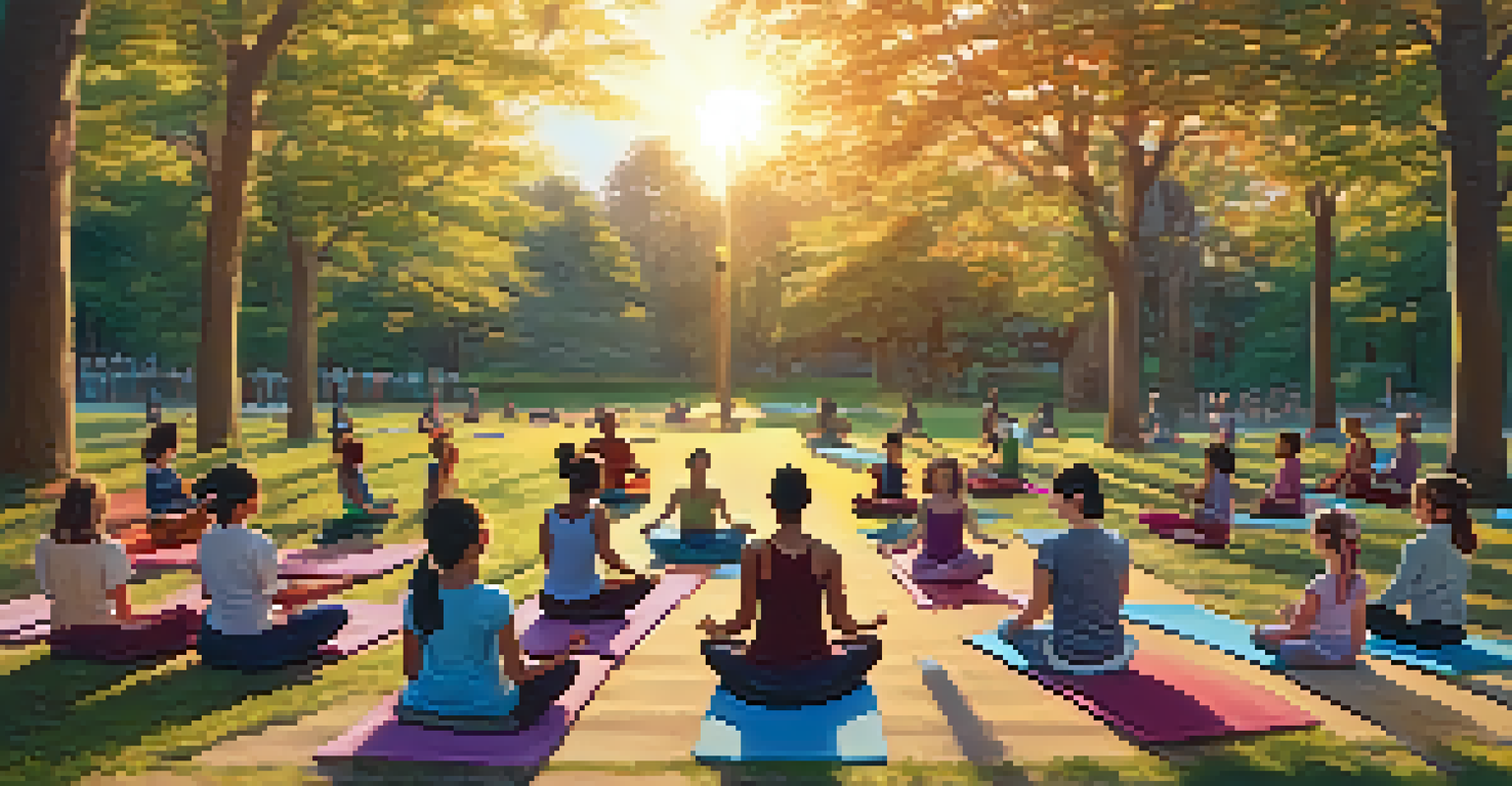Health and Wellness Trends in Urban Living

The Rise of Green Spaces in Urban Environments
Urban areas are increasingly incorporating green spaces to promote health and well-being. Parks and community gardens not only provide a breath of fresh air but also serve as social hubs. Studies show that spending time in nature reduces stress and improves mental health, making these spaces essential in bustling cities.
Green spaces are not a luxury, they are a necessity for our health and well-being.
For example, cities like New York and London have transformed vacant lots into vibrant gardens and parks, encouraging residents to connect with nature. These initiatives not only enhance the aesthetic appeal of neighborhoods but also foster a sense of community. As urban dwellers seek respite from concrete jungles, green spaces have become a vital aspect of city planning.
Moreover, these environments promote physical activity, encouraging people to walk, jog, or simply enjoy outdoor yoga. As more urban planners recognize the value of green spaces, we can expect to see an increase in initiatives aimed at integrating nature into city life.
Wellness Apps: The Digital Solution for Healthy Living
In today's tech-driven world, wellness apps have become indispensable for urban dwellers seeking healthier lifestyles. From fitness tracking to meditation guidance, these apps cater to various health needs and preferences. With just a few taps, users can access workouts, meal plans, and mindfulness exercises directly from their smartphones.

For instance, apps like MyFitnessPal and Headspace have garnered millions of users by offering personalized experiences. This accessibility empowers individuals to take charge of their health in a way that fits their busy schedules. As urban life often comes with time constraints, wellness apps provide a flexible solution for maintaining a balanced lifestyle.
Green Spaces Enhance Urban Well-Being
Integrating parks and gardens in cities promotes mental health and community connections.
Furthermore, many apps foster a sense of community by allowing users to connect with others who share similar goals. This social aspect not only motivates individuals but also creates a support network that can be crucial in achieving wellness goals. By blending technology with health, these apps are revolutionizing the way urban residents approach wellness.
Mindfulness Practices Gaining Popularity in Cities
As urban living can be fast-paced and overwhelming, many residents are turning to mindfulness practices to enhance their well-being. Techniques such as meditation, yoga, and deep-breathing exercises are becoming commonplace in city life. These practices help individuals manage stress and promote mental clarity amidst the chaos of urban environments.
The greatest weapon against stress is our ability to choose one thought over another.
Local studios and community centers often offer classes tailored for busy city dwellers, making mindfulness accessible to all. For example, outdoor yoga classes in parks allow participants to connect with nature while practicing relaxation techniques. This combination not only elevates the experience but also helps foster community bonds.
Additionally, workplaces are increasingly recognizing the benefits of mindfulness, with many offering programs that encourage employees to take breaks for meditation or relaxation. By integrating these practices into daily routines, urban residents can cultivate a healthier mindset, ultimately leading to improved overall well-being.
Healthy Eating Trends: Farm-to-Table Movement
The farm-to-table movement is reshaping how urban dwellers approach food. By emphasizing locally sourced ingredients, restaurants and markets are making it easier for residents to enjoy fresh, nutritious meals. This trend not only supports local farmers but also reduces the carbon footprint associated with food transportation.
For example, many cities now host farmers' markets where residents can buy seasonal produce directly from local growers. This not only fosters a connection between consumers and producers but also encourages healthier eating habits. By choosing fresh, whole foods, urbanites are becoming more conscious of their dietary choices.
Wellness Apps Empower Healthy Living
Technology enables urban residents to maintain healthier lifestyles through accessible health resources.
Moreover, restaurants that prioritize farm-to-table practices are gaining popularity, often featuring menus that change with the seasons. This not only enhances the dining experience but also reflects a growing awareness of the importance of sustainable eating. As more people embrace this trend, we can expect to see a positive impact on both health and the environment.
Fitness Trends: Group Workouts and Community Engagement
Group workouts are surging in popularity among urban dwellers, offering both fitness and social interaction. Activities like cycling classes, boot camps, and dance sessions create a sense of community while motivating participants to stay active. This trend reflects a shift towards collective fitness experiences, rather than solitary workouts.
Many cities now feature outdoor fitness events that encourage residents to engage with their neighbors while improving their health. For instance, community yoga sessions in local parks or group runs along scenic routes build camaraderie and accountability. Such events make exercise more enjoyable and less daunting for those new to fitness.
Additionally, fitness studios and gyms are responding to this trend by incorporating more group classes into their offerings. This not only attracts more members but also fosters a supportive environment where individuals can thrive together. As urbanites seek connection and motivation, group workouts are becoming a staple in the health and wellness landscape.
Sustainable Living Practices in Urban Areas
Sustainability is becoming a central theme in urban living, influencing how residents approach health and wellness. From eco-friendly housing to zero-waste initiatives, many city dwellers are adopting practices that promote both personal well-being and environmental health. This shift reflects a growing awareness of the interconnectedness of our health and the planet's health.
For example, urban gardening and composting are gaining traction as ways to reduce waste and promote sustainable food sources. Residents are increasingly looking for ways to grow their own food, even in small spaces, and engage in practices that minimize their ecological footprint. This not only benefits the environment but also encourages healthier eating habits.
Sustainable Practices Shape City Life
Adopting eco-friendly habits not only benefits personal health but also supports environmental sustainability.
Moreover, sustainable transportation options like biking and walking are being embraced as alternatives to driving. By opting for these modes of transport, urban dwellers can improve their physical health while reducing air pollution and traffic congestion. As the movement towards sustainable living continues to grow, it will undoubtedly shape the future of health and wellness in urban settings.
The Importance of Sleep and Rest in Urban Living
In the hustle and bustle of city life, the importance of sleep often gets overlooked. However, urban residents are beginning to recognize that restorative sleep is crucial for overall health and well-being. As stress levels rise and schedules get packed, prioritizing rest is more important than ever.
Many are now adopting practices aimed at improving sleep hygiene, such as reducing screen time before bed and creating calming bedtime routines. This shift reflects an understanding that quality sleep can enhance productivity, mood, and physical health. For example, sleep apps that track patterns and provide relaxation techniques are becoming popular tools for city dwellers.

Additionally, some cities are implementing initiatives to promote healthier sleep environments, such as noise reduction programs and increased access to quiet spaces. By fostering a culture that values rest, urban areas can support the well-being of their residents. As more people prioritize sleep, the benefits will ripple through communities, leading to healthier, happier lives.